Contents

This book is designed to be your personal crochet tutor: it will teach you everything you need to know about the craft, whether you are new to it, returning after a break, or an advanced beginner who wants to improve. Crochet, rewarding as it is, can take a while to master, and I know the frustration that comes from getting half-way through a project only to realise its gone completely wrong. Having to go back and start again can be disheartening and so, this book aims to preempt problems rather than address them retrospectively. Troubleshooting tips show you common pitfalls and help you ensure you have the right technique to get it right the first time. In this book, you will first become familiar with the materials needed for crochet, including an in-depth discussion of yarn, hooks, and how to substitue these if needed. There is a huge variety of materials available for purchase, and you will be primed to make smart choices when selecting items for your projects.
You will then learn the techniques and stitches that are used in patterns and projects. Remember that at these early stages, its important to be patient; while it may be tempting to rush into making your first granny square, take a step back and practice basics such as learning to hold the hook and yarn correctly first. This is harder than you think but it gets easier with practice and will be worth the time spent on it. When choosing your first project, it is a good idea to start with small items that can be finished quickly as this will help build your confidence. Blanket squares, for instance, are a great option because they can be made individually, one at a time, and then joined together to make a larger item. This can feel like a great accomplishment as it has the ease of a small project and the satisfaction of a working on a big piece.
Please see Chapter 9 for granny square and closed square patterns. Stuffed toys are also a good choice; the sphere, tube, and hourglass patterns in the same chapter are a good place to start, as they incorporate all the necessary skills to crochet in three dimensions. It should be noted that all text is written in American stitch terms. New crocheters might be surprised to learn that there are different stitch terms used in Europe and other parts of the world. Please see International terms and Yarn weights for more information.  ACRYLIC A synthetic yarn in which man-made fibers are plied together to make yarn, often imitating animal fibers.
ACRYLIC A synthetic yarn in which man-made fibers are plied together to make yarn, often imitating animal fibers.
ALPACA Yarn made from the alpacas coat. Warm and highly insulative, often incorporates little hairs that make its appearance fuzzy. ANGORA Yarn made from the angora rabbits coat. Very fuzzy/hairy, produces a distinctive, extremely soft fabric. BALL A length of yarn wound into a sphere or oblong shape. Can refer to machine-wound or hand-wound balls.
BALL BAND The wrapper on a commercially purchased ball/skein of yarn. Will include information about dye lot, suggested needle/hook size, yardage/meterage, average tension, etc. BALL WINDER A device that will wind yarn from a skein into a ball/cake. BLOCKING Using water and sometimes steam to smooth your crochet, improving its appearance, straightening edges, and opening up openwork patterns. BOUCL Yarn in which one of multiple plies is twisted more loosely than the others, forming distinctive loops. BULKY/CHUNKY A thick weight of yarn, ranging from just thicker than aran all the way up to super-bulky/rug yarn.
CASHMERE Yarn made from the cashmere goats coat. Very luxurious, generally the most expensive yarn on the market. CROCHET HOOK PARTS Bowl The area under the lip of a crochet hook. Head The tip of the hook, used to insert into the stitch. Lip The hook part of a crochet hook. Pad On some crochet hooks, a depression to rest the thumb.
Shank The long part of the hook between the lip and pad. Throat The part of the hook just below the lip, usually smaller in circumference than the shank. DECREASING To subtract stitches to a crocheted piece, usually one at a time. To decrease in a pattern usually means to subtract one stitch from the existing number of stitches. DK A medium-weight yarn, also referred to as light worsted. Most popular yarn weight in the Europe.
DYE LOT The batch of dye in which a yarn is dyed. All yarn for one project should come from the same dye lot, noted on the ball band. FOUNDATION CHAIN A chain made at the base or bottom of a piece of crochet, generally worked into in rows. GAUGE/TENSION Generally refers to the specific number of stitches per a certain measurement, usually 4 in/10 cm. Can also refer to a crocheters individual gauge (tightness) when crocheting, and also the size of hook. GAUGE/TENSION SWATCH A practice square made before starting a project to determine a crocheters individual gauge.
Generally measured by 4 in/10 cm. HANK A skein of yarn that has been looped into a figure-8 shape. HOOK GAUGE Also called a needle gauge, used to size crochet hooks and knitting needles. INCREASING To add stitches to a crocheted piece, usually one at a time. To increase in a pattern usually means to add one stitch to the existing number of stitches. LACEWEIGHT A very fine-weight yarn, used to make lacy items.
Also referred to as thread or cobweb. MERINO Yarn made from the merino sheeps coat. Very soft, higher in price than other animal fibers, warm and insulative. MOHAIR Yarn made from the angora goats coat. Extremely fuzzy/hairy, it can be challenging to work with, but makes fabric that is remarkably lightweight while still very warm. Often sold in laceweight.
MOTIF/MEDALLION An individual smaller shape that is often used in multiples to create a larger piece. Motifs can be square, hexagonal, or many other shapes. Usually worked in the round. PICOT A small point or loop used to accent in crochet. ESSENTIAL CROCHET TERMS PILLING The excess gathering of fluff on fabric or yarn, caused by the separation of the short fibers from the long. PLIED YARN Yarn in which individual strands are twisted together to make one larger strand.
The ply refers to the twist. POST The vertical section of a stitch. RIGHT SIDE The front or outside of a piece of crochet, as it will be used or worn. ROW GAUGE The vertical gaugethe number of rows per 4 in/10 cm. SCHEMATIC An illustration of a finished crochet piece, often a garment, that may be included with a pattern and will give measurements of individual sections of the piece. SINGLE-PLY A misnomer, as single-ply yarn is made up of one individual strand, and is not plied at all.
SKEIN A length of yarn arranged into a long loop. Must be wound into a ball before use. SLUB The bump of fiber found in an uneven yarn spin. STITCH GAUGE The horizontal gaugethe number of stitches per 4 in/10 cm. SWIFT A tool with an adjustable diameter, used to hold yarn while it is being wound. TURNING CHAIN A chain made at the beginning of a row or round, to raise the crochet up to the height of the stitch about to be worked.
The number of chains made for the turning chain is determined by which stitch will be worked in the row or round. VARIEGATED YARN Yarn that is dyed with more than one color. This may sometimes include gradients or shades of the same color. WEIGHT Refers to the thickness of the strand of a yarn. WOOL Can refer to yarn made from several animals, most notably the sheep. Can range from soft to coarse.
WORKING LOOP The loop on the hook at any given time. WORKING YARN The yarn connected to the ball. WORSTED/ARAN A medium-weight yarn. Most popular yarn weight in North America. WRONG SIDE The back or inside of a piece of crochet, as it will be used or worn. 

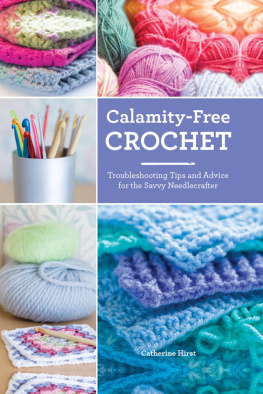
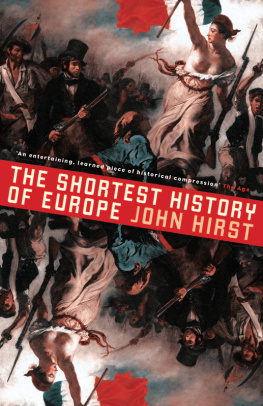
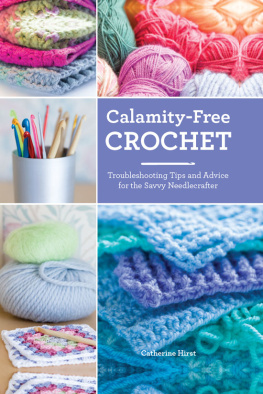
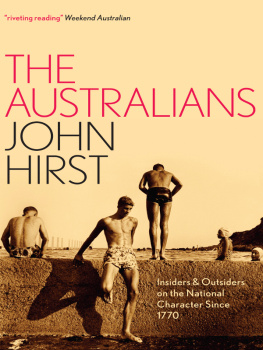
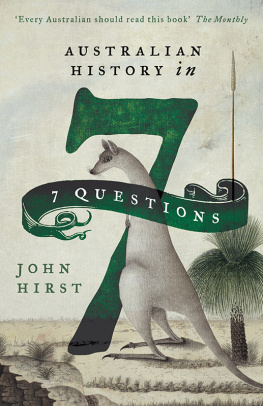
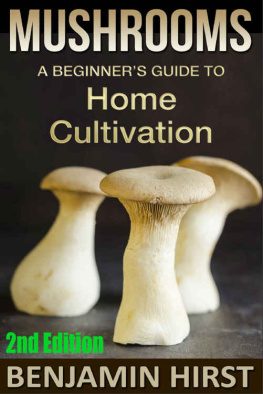

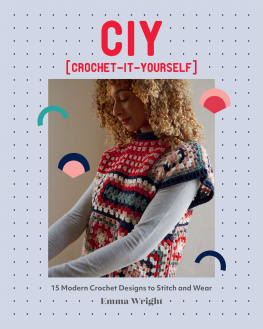
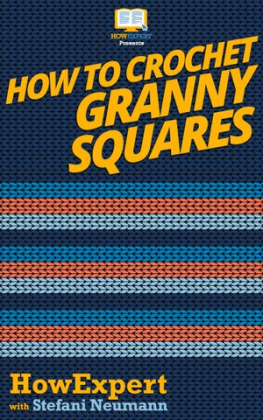




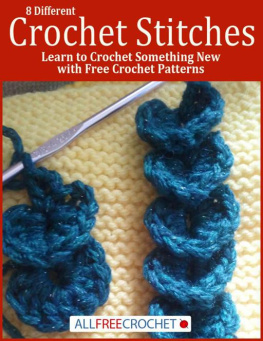
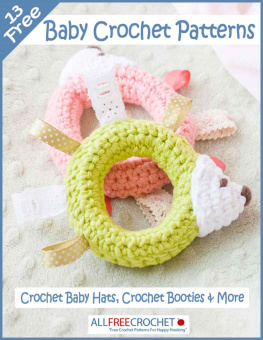

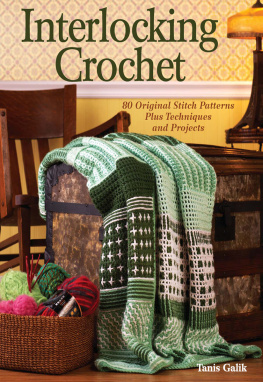

 This book is designed to be your personal crochet tutor: it will teach you everything you need to know about the craft, whether you are new to it, returning after a break, or an advanced beginner who wants to improve. Crochet, rewarding as it is, can take a while to master, and I know the frustration that comes from getting half-way through a project only to realise its gone completely wrong. Having to go back and start again can be disheartening and so, this book aims to preempt problems rather than address them retrospectively. Troubleshooting tips show you common pitfalls and help you ensure you have the right technique to get it right the first time. In this book, you will first become familiar with the materials needed for crochet, including an in-depth discussion of yarn, hooks, and how to substitue these if needed. There is a huge variety of materials available for purchase, and you will be primed to make smart choices when selecting items for your projects.
This book is designed to be your personal crochet tutor: it will teach you everything you need to know about the craft, whether you are new to it, returning after a break, or an advanced beginner who wants to improve. Crochet, rewarding as it is, can take a while to master, and I know the frustration that comes from getting half-way through a project only to realise its gone completely wrong. Having to go back and start again can be disheartening and so, this book aims to preempt problems rather than address them retrospectively. Troubleshooting tips show you common pitfalls and help you ensure you have the right technique to get it right the first time. In this book, you will first become familiar with the materials needed for crochet, including an in-depth discussion of yarn, hooks, and how to substitue these if needed. There is a huge variety of materials available for purchase, and you will be primed to make smart choices when selecting items for your projects.  ACRYLIC A synthetic yarn in which man-made fibers are plied together to make yarn, often imitating animal fibers.
ACRYLIC A synthetic yarn in which man-made fibers are plied together to make yarn, often imitating animal fibers.